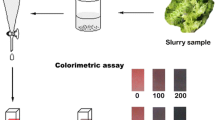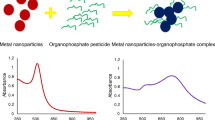Abstract
The authors describe a semi-quantitative colorimetric method for visual detection of organophosphorus pesticides (OPs). It is based on the aspect ratio dependent absorbance of gold nanorods (AuNRs) which is due to the localized surface plasmon resonance. The aspect ratio can be tailored by the Au(III) complex formed with cetyltrimethylammonium bromide (CTAB) which is affected by acetylcholinesterase (AChE) based hydrolysis. OPs act as inhibitors of this reaction. In the absence of OPs, the product (thiocholine) of enzymatic hydrolysis consumes almost all the Au(III) species. In this case, the amount of residual Au(III)-CTAB complexes is small, and etching of the AuNRs does not occur. In the presence of OPs, however, the activity of AChE is inhibited. Hence, only small quantities of (or no) thiocholine is produced, and Au(III) is not consumed. Au(III) is capable of etching AuNRs and to change their aspect ratio. This leads to a color change from brownish to gray, cyan, green, blue, purple, red, and colorless that can be easily observed with bare eyes. The AuNRs were incorporated into cellulose paper to obtain a paper stripe for visual detection of OPs. Under optimal conditions, both methods (AuNRs in aqueous solutions and on paper) allowed various OPs to be determined. Applied to parathion, the method had a detection limit as low as 1.2 ppb and a linear range from 0.01 to 1.84 ppm. It was applied to the analysis of cabbage washing solutions and sea water samples, and acceptable accuracy and good resolution were found. In our preconception, the method represents a valuable tool for on-site detection of OPs in agriculture products and food.

Schematic of a semi-quantitative method for the visual detection of organophosphate pesticides based on etching of gold nanorods. A color change from brownish to gray, green, blue, purple, red, and colorless can be observed and correlated to the concentration of pesticides.





Similar content being viewed by others
References
Chauhan N, Pundir CS (2011) An amperometric biosensor based on acetylcholinesterase immobilized onto iron oxide nanoparticles/multi-walled carbon nanotubes modified gold electrode for measurement of organophosphorus insecticides. Anal Chim Acta 701:66–74
Kumar P, Kim KH, Deep A (2015) Recent advancements in sensing techniques based on functional materials for organophosphate pesticides. Biosens Bioelectron 70:469–481
Fahimi-Kashani N, Hormozi-Nezhad MR (2016) Gold-nanoparticle-based colorimetric sensor array for discrimination of organophosphate pesticides. Anal Chem 88:8099–8106
Du D, Chen SZ, Cai J, Zhang AD (2007) Immobilization of acetylcholinesterase on gold nanoparticles embedded in sol–gel film for amperometric detection of organophosphorous insecticide. Biosens Bioelectron 23:130–134
Arduini F, Cinti S, Scognamiglio V, Moscone D (2016) Nanomaterials in electrochemical biosensors for pesticide detection: advances and challenges in food analysis. Microchim Acta 183:2063–2083
Cappiello A, Famiglini G, Palma P, Mangani F (2002) Trace level determination of organophosphorus pesticides in water with the new direct-electron ionization LC/MS interface. Anal Chem 74:3547–3554
Noort D, Fidder A, Schans MJ, Hulst AG (2006) Verification of exposure to organophosphates: generic mass spectrometric method for detection of human butyrylcholinesterase adducts. Anal Chem 78:6640–6644
You HJ, Hua XD, Feng L, Sun NN, Rui Q, Wang LM, Wang MH (2017) Competitive immunoassay for imidaclothiz using upconversion nanoparticles and gold nanoparticles as labels. Microchim Acta 184:1085–1092
Virel A, Saa L, Pavlov V (2009) Modulated growth of nanoparticles. Application for sensing nerve gases. Anal Chem 81:268–272
Wang M, Gu XG, Zhang GX, Zhang DQ, Zhu DB (2009) Continuous colorimetric assay for acetylcholinesterase and inhibitor screening with gold nanoparticles. Langmuir 25:2504–2507
Liang MM, Kelong F, Pan Y, Jiang H, Wang F, Yang DL, Lu D, Feng J, Zhao JJ, Yang L, Yan XY (2013) Fe3O4 magnetic nanoparticle peroxidase mimetic-based colorimetric assay for the rapid detection of organophosphorus pesticide and nerve agent. Anal Chem 85:308–312
Yan X, Song Y, Wu XL, Zhu CZ, Su XG, Du D, Lin YH (2017) Oxidase-mimicking activity of ultrathin MnO2 nanosheets in colorimetric assay of acetylcholinesterase activity. Nano 9:2317–2323
Pavlov V, Xiao Y, Willner I (2005) Inhibition of the acetycholine esterase-stimulated growth of au nanoparticles: nanotechnology-based sensing of nerve gases. Nano Lett 5:649–653
Fu GL, Chen WW, Yue XL, Jiang XY (2013) Highly sensitive colorimetric detection of organophosphate pesticides using copper catalyzed click chemistry. Talanta 103:110–115
Bala R, Sharma RK, Wangoo N (2015) Highly sensitive colorimetric detection of ethyl parathion using gold nanoprobes. Sensors Actuators B 210:425–430
Sun JF, Guo L, Bao Y, Xie JW (2011) A simple, label-free AuNPs-based colorimetric ultrasensitive detection of nerve agents and highly toxic organophosphate pesticide. Biosens Bioelectron 28:152–157
Li HK, Guo JJ, Ping H, Liu LR, Zhang MW, Guan FR, Sun CY, Zhang Q (2011) Visual detection of organophosphorus pesticides represented by mathamidophos using au nanoparticles as colorimetric probe. Talanta 87:93–99
Liu DB, Chen WW, Wei JH, Li XB, Wang Z, Jiang XY (2012) A highly sensitive, dual-readout assay based on gold nanoparticles for organophosphorus and carbamate pesticides. Anal Chem 84:4185–4191
Wu S, Li DD, Wang JM, Zhao YQ, Dong SJ, Wang XY (2017) Gold nanoparticles dissolution based colorimetric method for highly sensitive detection of organophosphate pesticides. Sensors Actuators B 238:427–433
Kumar J, D’Souz SF (2010) An optical microbial biosensor for detection of methyl parathion using Sphingomonas sp. immobilized on microplate as a reusable biocomponent. Biosens Bioelectron 26:1292–1296
Lv BJ, Wei M, Liu YJ, Liu X, Wei W, Liu SQ (2016) Ultrasensitive photometric and visual determination of organophosphorus pesticides based on the inhibition of enzyme-triggered formation of core-shell gold-silver nanoparticles. Microchim Acta 183:2941–2948
Ma XM, Chen ZT, Kannan P, Lin ZY, Qiu B, Guo LH (2016) Gold nanorods as colorful chromogenic substrates for semiquantitative detection of nucleic acids, proteins, and small molecules with the naked eye. Anal Chem 88:3227–3234
Lu LL, Xia YS (2015) Enzymatic reaction modulated gold nanorod end-to-end self-assembly for ultrahigh sensitively colorimetric sensing of cholinesterase and organophosphate pesticides in human blood. Anal Chem 87:8584–8591
Saa L, Grinyte R, Sánchez-Iglesias A, Liz-Marzán LM, Pavlov V (2016) Blocked enzymatic etching of gold nanorods: application to colorimetric detection of acetylcholinesterase activity and its inhibitors. ACS Appl Mater Interfaces 8:11139–11146
Lee SJ, Nam YS, Choi SH, Lee Y, Lee KB (2016) Highly sensitive photometric determination of cyanide based on selective etching of gold nanorods. Microchim Acta 183:3035–3041
Ye XC, Jin LH, Caglayan H, Chen J, Xing GZ, Zheng C, Nguyen VD, Kang YJ, Engheta N, Kagan CR, Murray CB (2012) Improved size-tunable synthesis of monodisperse gold nanorods through the use of aromatic additives. ACS Nano 6:2804–2817
Liang PP, Yu HX, Guntupalli B, Xiao Y (2015) Paper-based device for rapid visualization of NADH based on dissolution of gold nanoparticles. ACS Appl Mater Interfaces 7:15023–15030
Rodríguez-Fernández J, Pérez-Juste J, Mulvaney P, Liz-Marzán LM (2005) Spatially-directed oxidation of gold nanoparticles by au (III)−CTAB complexes. J Phys Chem B 109:14257–14261
Nikoobakht B, El-Sayed MA (2003) Preparation and growth mechanism of gold nanorods (NRs) using seed-mediated growth method. Chem Mater 15:1957–1962
Eguílaz M, Gutierrez F, González-Domínguez JM, Martínez MT, Rivas G (2016) Single-walled carbon nanotubes covalently functionalized with polytyrosine: a new material for the development of NADH-based biosensors. Biosens Bioelectron 86:308–314
Du D, Wang J, Wang LM, Lu DL, Lin YH (2012) Integrated lateral flow test strip with electrochemical sensor for quantification of phosphorylated cholinesterase: biomarker of exposure to organophosphorus agents. Anal Chem 84:1380–1385
Zhao WW, Ma ZY, Yan DY, Xu JJ, Chen HY (2012) In situ enzymatic ascorbic acid production as electron donor for CdS quantum dots equipped TiO2 nanotubes: a general and efficient approach for new photoelectrochemical immunoassay. Anal Chem 84:10518–10521
Acknowledgements
The authors gratefully acknowledge the financial support of the National Natural Science Foundation of China (Nos. 21675018 and 21275024) and the Fundamental Research Funds for the Central Universities (No. DUT15LK33 and DUT16LK25).
Author information
Authors and Affiliations
Corresponding author
Ethics declarations
The authors declare that they have no competing interests.
Electronic supplementary material
ESM 1
(DOCX 662 kb)
Rights and permissions
About this article
Cite this article
Wu, S., Li, D., Gao, Z. et al. Controlled etching of gold nanorods by the Au(III)-CTAB complex, and its application to semi-quantitative visual determination of organophosphorus pesticides. Microchim Acta 184, 4383–4391 (2017). https://doi.org/10.1007/s00604-017-2468-9
Received:
Accepted:
Published:
Issue Date:
DOI: https://doi.org/10.1007/s00604-017-2468-9




